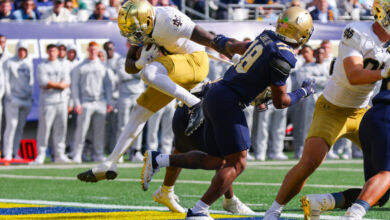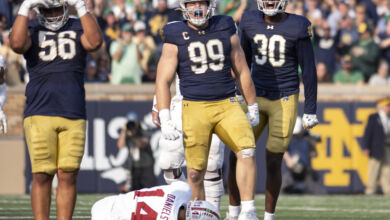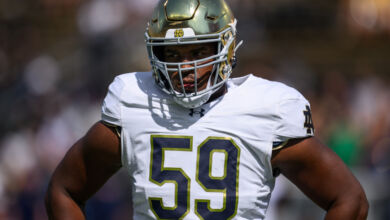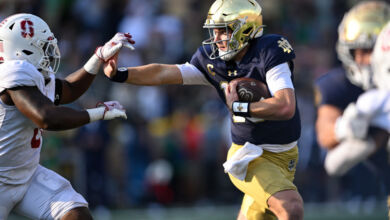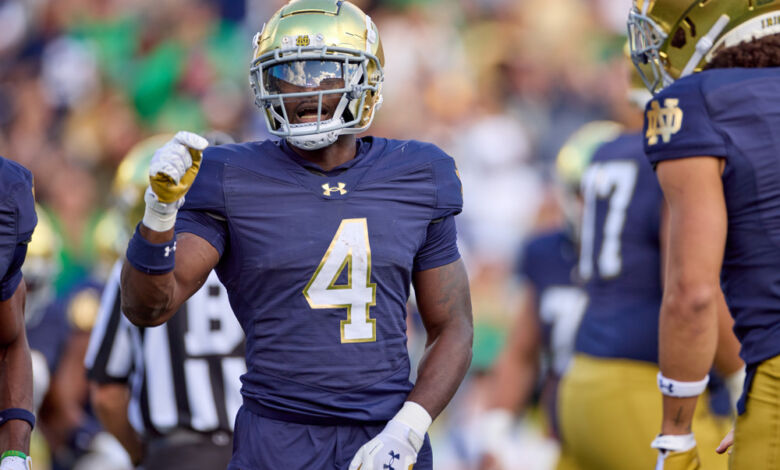
Entering a game that it has to win, Notre Dame football’s battle against Louisville on Saturday could lay the groundwork for a solid momentum boost toward a playoff berth. Of course, a loss effectively ends any such hopes and relegates the Irish to another bowl game that simply closes out the season. Some of the numbers each team has compiled in 2024 could help offer some potential insight into determining the outcome.
Running Together
Both teams rely on multiple runners to fuel the ground game, with one of those Notre Dame runners being quarterback Riley Leonard. He’s coming off his best game yet, with his 143 yards against Miami of Ohio highlighted by runs of 43 and 50 yards. Yet, he’s more likely to supplement the work of the two regular Irish backs, Jeremiyah Love and Jararian Price. That’s because that duo is averaging 7.4 yards per carry, though Leonard’s two big runs boosted his per-carry clip to seven yards even.
Each time that Notre Dame and Louisville carry the ball, they average over six yards every time they run the ball, with Notre Dame using it 13 times to reach the end zone, compared to just eight for Louisville. The Cardinals don’t have any dominant runner, preferring to focus on five different backs who’ve gained all but 19 of the 590 yards they’ve gained. Unlike Notre Dame, Louisville’s starting quarterback Tyler Shough isn’t a threat to take off at any point, with just 15 yards on seven carries.
Entering this contest, the Cardinals have done better this season in stopping opposing running attacks, allowing just 2.54 yards per carry and putting them in the top 20 among all FBS teams. They also showed the Irish last year just how strong this unit is, limiting Notre Dame to just 44 yards on 28 carries.
In contrast, the Irish have had inexplicable lapses when trying to stop the run against a pair of MAC schools in Northern Illinois and Miami. That 3.56 opposing carry average helped drop them into a tie for 51st with Fresno State in the NCAA statistics. Shutting down the Louisville running game would force the Cardinals to rely on their air game, which has heavily relied on one wideout, J’Courey Brooks, this season.
Sacks Appeal
The difference in quarterback mobility can be seen in part by the respective rushing yardage gained by each signal-caller. Yet, due to Notre Dame’s issues with its offensive line this season, it’s Louisville that’s allowed the fewer sacks. In the four Irish contests, they’ve allowed seven quarterback sacks, compared to just two for the Cardinals in their three contests.
This particular statistic will strike a nerve with Notre Dame and its fans since it was in last year’s loss at Louisville that Sam Hartman was sacked five times. In the first three games, the Cardinals are averaging three sacks per game and have collected 10 quarterback hurries. In that latter category, the Irish have 12 hurries to their credit, one of the reasons why the defense has allowed just three touchdowns over 16 quarters.
The aforementioned concerns about Notre Dame’s offensive line were there when the season began due to the five-man unit having a total of just six collegiate starts to their credit. That unit then suffered a blow in the third game with the season-ending injury to Ashton Craig. Against a formidable pass-rushing team like Louisville and its key players in Ashton Gillotte and Tramel Logan, the Irish need to try and neutralize their opponents or at least limit the damage to win.
Quarter Scan
With the exception of the Purdue blowout, Notre Dame has had its problems getting started in the opening period. While they took a quick 14-0 lead over the Boilermakers in that rout, the other three games have seen them outscored in the first, 13-10. A repeat of that trio of contests could be deadly since Louisville has outscored its foes in the first, 31-7.
The final three quarters have been dominated by both teams, especially in the second half. During the second quarter, the Irish hold a strong 45-9 advantage, compared to the Cardinals outscoring their opponents, 52-21. However, Louisville has been dominant once it returns from its break, outscoring the three foes, 59-5. Notre Dame has also made its mark in the second half, with a 62-17 advantage.
That leaves the question of which team can keep its dominance over that stretch going. Neither can’t afford to struggle heading into halftime, given the respective success its opponent has had. For the Irish, ending up on the short end of this equation would not only crumble a playoff goal but send them into their bye week trying to pick up the pieces.
